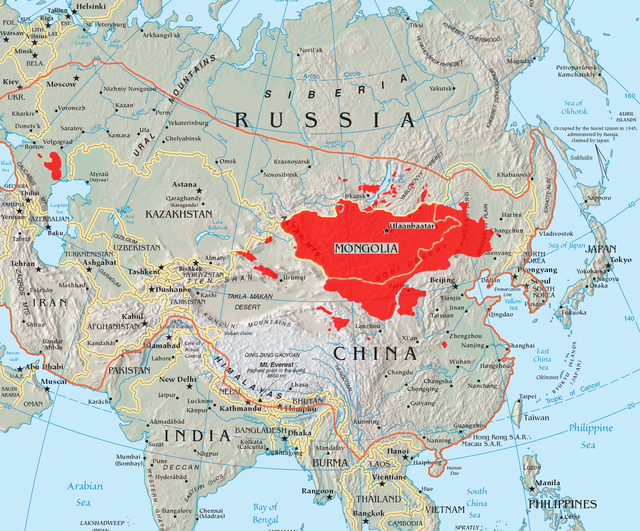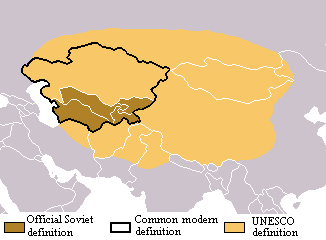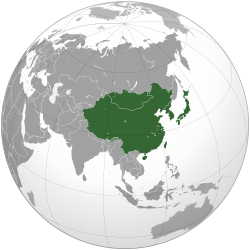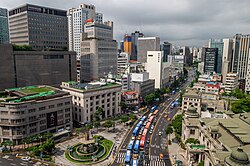Top Qs
Timeline
Chat
Perspective
East Asia
Subregion of the Asian continent From Wikipedia, the free encyclopedia
Remove ads
East Asia is a geocultural region of Asia. It includes China, Japan, Mongolia, North Korea, South Korea, and Taiwan,[2][3] plus two special administrative regions of China, Hong Kong and Macau. The economies of China, Japan, South Korea, and Taiwan are among the world's largest and most prosperous. East Asia borders North Asia to the north, Southeast Asia to the south, South Asia to the southwest, and Central Asia to the west. To its east is the Pacific Ocean.
East Asia, especially Chinese civilization, is regarded as one of the earliest cradles of civilization. Other ancient civilizations in East Asia that still exist as independent countries in the present day include the Japanese, Korean, and Mongolian civilizations. Various other civilizations existed as independent polities in East Asia in the past but have since been absorbed into neighbouring civilizations in the present day, such as Tibet, Manchuria, and Ryukyu (Okinawa), among many others. Taiwan has a relatively young history in the region after the prehistoric era; originally, it was a major site of Austronesian civilisation prior to colonisation by European colonial powers and China from the 17th century onward. For thousands of years, China was the leading civilization in the region, exerting influence on its neighbours.[5][6][7] Historically, societies in East Asia have fallen within the Chinese sphere of influence, and East Asian vocabularies and scripts are often derived from Classical Chinese and Chinese script. The Chinese calendar serves as the root from which many other East Asian calendars are derived.
Major religions in East Asia include Buddhism (mostly Mahayana),[8] Confucianism and Neo-Confucianism, Taoism,[9] ancestral worship, and Chinese folk religion in Mainland China, Hong Kong, Macau and Taiwan, Shinto in Japan, and Christianity and Musok in Korea.[10][11][12] Tengerism and Tibetan Buddhism are prevalent among Mongols and Tibetans while other religions such as Shamanism are widespread among the indigenous populations of northeastern China such as the Manchus.[13] The major languages in East Asia include Mandarin Chinese, Japanese, and Korean. The major ethnic groups of East Asia include the Han in China and Taiwan, Yamato in Japan, Koreans in North and South Korea, and Mongols in Mongolia. There are 76 officially-recognized minority or indigenous ethnic groups in East Asia; 55 native to mainland China (including Hui, Manchus, Chinese Mongols, Tibetans, Uyghurs, and Zhuang in the frontier regions), 16 native to the island of Taiwan (collectively known as Taiwanese indigenous peoples), one native to the major Japanese island of Hokkaido (the Ainu) and four native to Mongolia (Turkic peoples). The Ryukyuan people are an unrecognized ethnic group indigenous to the Ryukyu Islands in southern Japan, which stretch from Kyushu to Taiwan. There are also several unrecognized indigenous ethnic groups in mainland China and Taiwan.
East Asians comprise around 1.7 billion people, making up about 33% of the population in continental Asia and 20% of the global population.[14][needs update] The region is home to major world metropolises such as Beijing–Tianjin, Busan–Daegu–Ulsan–Changwon, Guangzhou, Hong Kong, Osaka–Kyoto–Kobe, Seoul, Shanghai, Shenzhen, Taipei, and Tokyo. Although the coastal and riparian areas of the region form one of the world's most populated places, the population in Mongolia and Western China, both landlocked areas, is very sparsely distributed, with Mongolia having the lowest population density of a sovereign state. The overall population density of the region is 133 inhabitants per square kilometre (340/sq mi), about three times the world average of 45/km2 (120/sq mi).[when?][citation needed]
Remove ads
History
Summarize
Perspective
Ancient era
China was the first region settled in East Asia and was undoubtedly the core of East Asian civilization from where other parts of East Asia were formed. The various other regions in East Asia were selective in the Chinese influences they adopted into their local customs. Historian Ping-ti Ho referred to China as the cradle of Eastern civilization, in parallel with the cradle of Middle Eastern civilization along the Fertile Crescent encompassing Mesopotamia and Ancient Egypt[15] as well as the cradle of Western civilization encompassing Ancient Greece.
Chinese civilization emerged early, and prefigured other East Asian civilisations. Throughout history, imperial China would exert cultural, economic, technological, and political influence on its neighbours.[16][17][18] Succeeding Chinese dynasties exerted enormous influence across East Asia culturally, economically, politically and militarily for over two millennia.[18][19][20] The tributary system of China shaped much of East Asia's history for over two millennia due to Imperial China's economic and cultural influence over the region, and thus played a huge role in the history of East Asia in particular.[21][22][17] Imperial China's cultural preeminence not only led the country to become East Asia's first literate nation in the entire region, it also supplied Japan and Korea with Chinese loanwords and linguistic influences rooted in their writing systems.[23]
Under Emperor Wu of Han, the Han dynasty made China the regional powerhouse in East Asia, projecting much of its imperial influence onto its neighbours.[18][24] Han China hosted the largest unified population in East Asia, the most literate and urbanised as well as being the most economically developed, as well as the most technologically and culturally advanced civilization in the region at the time.[25][26] Cultural and religious interaction between the Chinese and other regional East Asian dynasties and kingdoms occurred. China's impact and influence on Korea began with the Han dynasty's northeastern expansion in 108 BC when the Han Chinese conquered the northern part of the Korean peninsula and established a province called Lelang. Chinese influences were transmitted and soon took root in Korea through the inclusion of the Chinese writing system, monetary system, rice culture, philosophical schools of thought, and Confucian political institutions.[27] Jomon society in ancient Japan incorporated wet-rice cultivation and metallurgy through its contact with Korea. Starting in the fourth century AD, Japan adopted Chinese characters, which remain integral to the Japanese writing system. Utilizing the Chinese writing system allowed the Japanese to conduct their daily activities, maintain historical records and give form to various ideas, thoughts, and philosophies.
Medieval era

During the Tang dynasty, China exerted its greatest influence on East Asia as various aspects of Chinese culture spread to Japan and Korea.[28] The establishment of the medieval Tang dynasty rekindled the impetus of Chinese expansionism across the geopolitical confines of East Asia. Similar to its Han predecessor, Tang China reasserted itself as the center of East Asian geopolitical influence during the early medieval period which spearheaded and marked another golden age in Chinese history. During the Tang dynasty, China exerted its greatest influence on East Asia as various aspects of Chinese culture spread to Japan and Korea.[28][29] In addition, Tang China also managed to maintain control over northern Vietnam and northern Korea.[30]
As full-fledged medieval East Asian states were established, Korea by the fourth century AD and Japan by the seventh century AD, Japan and Korea actively began to incorporate Chinese influences such as Confucianism, the use of Chinese characters, architecture, state institutions, political philosophies, religion, urban planning, and various scientific and technological methods into their culture and society through direct contacts with Tang China and succeeding Chinese dynasties.[28][29][31] Drawing inspiration from the Tang political system, Prince Naka no oe launched the Taika Reform in 645 AD where he radically transformed Japan's political bureaucracy into a more centralised bureaucratic empire.[32] The Japanese also adopted Mahayana Buddhism, Chinese style architecture, and the imperial court's rituals and ceremonies, including the orchestral music and state dances had Tang influences. Written Chinese gained prestige and aspects of Tang culture such as poetry, calligraphy, and landscape painting became widespread.[32] During the Nara period, Japan began to aggressively import Chinese culture and styles of government which included Confucian protocol that served as a foundation for Japanese culture as well as political and social philosophy.[33][34] The Japanese created laws adopted from the Chinese legal system that was used to govern in addition to the kimono, which was inspired from Chinese hanfu during the 8th century.
Modern era

For many centuries, most notably from the 7th to the 14th centuries, China stood as East Asia's most advanced civilization and foremost military and economic power, exerting its influence as the transmission of advanced Chinese cultural practices and ways of thinking greatly shaped the region up until the 19th century.[35][36][37] From 3rd century through the 18th century, diplomatic and trade relations between China and other East Asian countries and the steppe kingdoms was governed through a tributary system.[38]: 13–14 Under this system, the Chinese emperor received tribute from other rulers and in return received political benefits (like recognition or non-aggression agreements) or physical gifts, like porcelain and silks.[38]: 14 Through this system, the Chinese emperor conferred legitimacy on other rulers.[38]: 14
As East Asia's connections with Europe and the Western world strengthened during the late 19th century, China's power began to decline.[16][39] By the mid-19th century, the weakening Qing dynasty became fraught with political corruption, obstacles and stagnation that was incapable of rejuvenating itself as a world power in contrast to the industrializing Imperial European colonial powers and a rapidly modernizing Japan.[40][41] The United States Commodore Matthew C. Perry would open Japan to Western influence, and the country would expand in earnest after the 1860s.[42][43][44] Around the same time, the Meiji Restoration in Japan sparked rapid societal transformation from an isolated feudal state into East Asia's first industrialised nation.[45][43] The modern and militarily powerful Japan would galvanise its position in the Orient as East Asia's greatest power with a global mission poised to advance to lead the entire world.[45][46] By the early 1900s, the Empire of Japan succeeded in asserting itself as East Asia's most dominant geopolitical force.[46]

With its newly found international status, Japan would begin to challenge the European colonial powers and inextricably took on a more active role within the East Asian geopolitical order and world affairs at large.[47] Flexing its nascent political and military might, Japan soundly defeated the stagnant Qing dynasty during the First Sino-Japanese War as well as defeating Russia in the Russo-Japanese War in 1905; the first major military victory in the modern era of an East Asian power over a European one.[48][49][50][42]
During World War I, European military presence in East Asia decreased.[51]: 34 Japan viewed this as an opportunity to increase its power in China and shortly after the war began, occupied Germany's concessions in Shandong.[51]: 34 In December 1914, Japan made its Twenty-One Demands to China.[51]: 34 The Republic of China under Yuan Shikai conceded to most of the demands in 1915, and subsequent treaties and agreements further increased Japan's semi-colonial power in China.[51]: 34
Japan hegemony was the heart of an empire that would include Taiwan and Korea.[45] During World War II, Japanese expansionism with its imperialist aspirations through the Greater East Asia Co-Prosperity Sphere would incorporate Korea, Taiwan, much of eastern China and Manchuria, Hong Kong, and Southeast Asia under its control establishing itself as a maritime colonial power in East Asia.[52]
Contemporary era
After a century of exploitation by the European and Japanese colonialists, post-colonial East Asia saw the defeat and occupation of Japan by the victorious Allies. The end of World War II did not result in east Asian countries obtaining independence or national unification.[38]: 4 Independence and national unification were primary concerns for the first generation of east Asian post-World War II leaders.[38]: 4
The Chinese Civil War resumed after the defeat of the Japanese, with the Communists defeating the Nationalist Republic of China government. The government of the Republic of China retreated to Taiwan and the People's Republic of China was proclaimed on 1 October 1949.
Post-war, the Korean peninsula was partitioned, leading to the development of the Democratic People's Republic of Korea (North Korea) and the Republic of Korea (South Korea). The Korean War (1950–1953) increased regional and international tensions.[53]: 163 The northeast part of East Asia hardened along communist and anti-communist lines.[53]: 163 South Korea, Taiwan, and the United States have increased their ties.[53]: 163
During the latter half of the 20th century, the region would see the post war economic miracle of Japan, which ushered in three decades of unprecedented growth, only to experience an economic slowdown during the 1990s, but nonetheless Japan continues to remain a global economic power. East Asia would also see the economic rise of Hong Kong, South Korea, and Taiwan, in addition to the respective handovers of Hong Kong and Macau near the end of the 20th century.
The onset of the 21st century in East Asia led to the integration of Mainland China into the global economy through its entry in the World Trade Organization while also enhancing its emerging international status as a potential world power reinforced with its aim of restoring its historical established significance and enduring international prominence in the world economy.[2][54][55][56][57][58][59][60]
As of at least 2022, the region is more peaceful, integrated, wealthy, and stable than at any time in the previous 150 years.[61]: 183
Remove ads
Definitions
Summarize
Perspective

In common usage, the term "East Asia" typically refers to a region including Greater China, Japan, Korea and Mongolia.[55][62][63][64][65][66][67][68]
China, Japan, and Korea represent the three core countries and civilizations of traditional East Asia, as they once had a shared written language, a shared culture, and a shared Confucian societal value system (involving shared Confucian philosophical tenets) once instituted by Imperial China.[69][70][71][72][73] Other usages define China, Hong Kong, Macau, Japan, North Korea, South Korea and Taiwan as countries that constitute East Asia based on their geographic proximity as well as historical and modern cultural and economic ties, particularly with Japan and Korea in having retained strong cultural influences that originated from China.[69][73][74][75][76] Some scholars include Vietnam as part of East Asia as it has been considered part of the greater Chinese cultural sphere. Though Confucianism continues to play an important role in Vietnamese culture, Chinese characters are no longer used in its written language and many scholarly organizations classify Vietnam as a Southeast Asian country.[77][78][79] Mongolia is geographically north of Mainland China yet Confucianism and the Chinese writing system and culture had limited impact on Mongolian society. Thus, Mongolia is sometimes grouped with Central Asian countries such as Turkmenistan, Kyrgyzstan, and Kazakhstan.[77][78] Xinjiang and Tibet are sometimes seen as part of Central Asia (see also Greater Central Asia).[80][81][82]
Broader and looser definitions by international agencies and organisations such as the World Bank refer to East Asia as the "three major Northeast Asian economies, i.e. mainland China, Japan, and South Korea", as well as Mongolia, North Korea, the Russian Far East, and Siberia.[83] The Council on Foreign Relations includes the Russia Far East, Mongolia, and Nepal.[84] The World Bank also acknowledges the roles of Chinese special administrative regions Hong Kong and Macau, as well as Taiwan, a country with limited recognition. The Economic Research Institute for Northeast Asia defines the region as "China, Japan, the Koreas, Nepal, Mongolia, and eastern regions of the Russian Federation".[85]


East Asia
The UNSD definition of East Asia is based on statistical convenience,[87] but others commonly use the same definition of Mainland China, Hong Kong, Macau, Mongolia, North Korea, South Korea, Taiwan, and Japan.[88][89]
Certain Japanese islands are associated with Oceania due to non-continental geology, distance from mainland Asia or biogeographical similarities with Micronesia.[90][91] Some groups, such as the World Health Organization, categorize China, Japan and Korea with Australia and the rest of Oceania. The World Health Organization label this region the "Western Pacific", with East Asia not being used in their concept of major world regions. Their definition of this region further includes Mongolia and the adjacent area of Cambodia, as well as the countries of the South East Asia Archipelago (excluding East Timor, Thailand, Myanmar and Indonesia).[92]
Alternative definitions
In the context of business and economics, "East Asia" is sometimes used to refer to the geographical area covering ten Southeast Asian countries in ASEAN, Greater China, Japan, and Korea. However, in this context, the term "Far East" is used by the Europeans to cover ASEAN countries and the countries in East Asia. On rare occasions, the term is also sometimes taken to include India and other South Asian countries that are not situated within the bounds of the Asia-Pacific, although the term Indo-Pacific is more commonly used for such a definition.[93]
Observers preferring a broader definition of "East Asia" often use the term Northeast Asia to refer to China, the Korean Peninsula, and Japan, with the region of Southeast Asia covering the ten ASEAN countries. This usage, which is seen in economic and diplomatic discussions, is at odds with the historical meanings of both "East Asia" and "Northeast Asia".[94][95][96] The Council on Foreign Relations of the United States defines Northeast Asia as Japan and Korea.[84]
Remove ads
Climate
Summarize
Perspective

East Asia is home to many climatic zones. It also has unique weather patterns such as the East Asian rainy season and the East Asian Monsoon.[97]
Climate change

Like the rest of the world, East Asia has been getting warmer due to climate change, and there had been a measurable increase in the frequency and severity of heatwaves.[99]: 1464 The region is also expected to see the intensification of its monsoon, leading to more flooding.[99]: 1459 China has notably embarked on the sponge cities program, where cities are designed to increase the area of urban green spaces and permeable pavings in order to help deal with flash floods caused by greater precipitation extremes.[99]: 1504 Under high-warming scenarios, "critical health thresholds" for heat stress during the 21st century will be at times breached,[99]: 1465 in areas like the North China Plain.[98]
China, Japan and the Republic of Korea are expected to see some of the largest economic losses caused by sea level rise.[99] The city of Guangzhou is projected to experience the single largest annual economic losses from sea level rise in the world, potentially reaching US$254 million by 2050. Under the highest climate change scenario and in the absence of adaptation, cumulative economic losses caused by sea level rise in Guangzhou would exceed US$1 trillion by 2100.[99] Shanghai is also expected to experience annual losses of around 1% of the local GDP in the absence of adaptation.[99] The Yangtze River basin is a sensitive and biodiverse ecosystem, yet around 20% of its species may be lost throughout the century under 2 °C (3.6 °F) and ~43% under 4.5 °C (8.1 °F).[99]: 1476
Remove ads
Economy
Remove ads
Territorial and regional data
China, North Korea, South Korea and Taiwan are all unrecognised by at least one other East Asian state because of severe ongoing political tensions in the region, specifically the division of Korea and the political status of Taiwan.
Etymology
Remove ads
Demographics
Summarize
Perspective


Religion
Religion in East Asia (est. 2020)[104]
- No Religion (52.0%)
- Folk religion (19.7%)
- Buddhism (19.4%)
- Christianity (5.71%)
- Islam (1.76%)
Ethnic groups
- Note: The order of states/territories follows the population ranking of each ethnicity, within East Asia only.
Remove ads
Culture
Summarize
Perspective
Overview
The culture of East Asia, has been deeply influenced by China, as it was the civilization that had the most dominant influence in the region throughout the ages that ultimately laid the foundation for East Asian civilization. The vast knowledge and ingenuity of Chinese civilization and the classics of Chinese literature and culture were seen as the foundations for a civilized life in East Asia. Imperial China served as a vehicle through which the adoption of Confucian ethical philosophy, Chinese calendar system, political and legal systems, architectural style, diet, terminology, institutions, religious beliefs, imperial examinations that emphasised a knowledge of Chinese classics, political philosophy and cultural value systems, as well as historically sharing a common writing system reflected in the histories of Japan and Korea.[114][18][115][116][117][73]
The Imperial Chinese tributary system was the bedrock of network of trade and foreign relations between China and its East Asian tributaries, which helped to shape much of East Asian affairs during the ancient and medieval eras. Through the tributary system, the various dynasties of Imperial China facilitated frequent economic and cultural exchange that influenced the cultures of Japan and Korea and drew them into a Chinese international order.[118] The Imperial Chinese tributary system shaped much of East Asia's foreign policy and trade for over two millennia due to Imperial China's economic and cultural dominance over the region, and thus played a huge role in the history of East Asia in particular.[22][118] The relationship between China and its cultural influence on East Asia has been compared to the historical influence of Greco-Roman civilization on classical Western civilisation.[117][118][114]
Since the late 19th century, the initially unequal encounter with Western influences has also shaped East Asia.[119]
Festivals
*Japan switched the date to the Gregorian calendar after the Meiji Restoration.
*Not always on that Gregorian date, sometimes April 4.
Entertainment
East Asian popular culture, such as anime and manga from Japan and K-pop and K-dramas from South Korea, have become highly popular worldwide in the 21st century.[120]
Sports

Baseball is one of the main sports in East Asia, having been introduced through mid-19th century American contact and further spread by the Japanese Empire.[121] The game has gained millions of fans in China since the 2010s.[122][unreliable source?]
East Asian Youth Games
Formerly the East Asian Games, it is a multi-sport event organized by the East Asian Games Association (EAGA) and held every four years since 2019 among athletes from East Asian countries and territories of the Olympic Council of Asia (OCA), as well as the Pacific island of Guam, which is a member of the Oceania National Olympic Committees.
It is one of five Regional Games of the OCA. The others are the Central Asian Games, the Southeast Asian Games (SEA Games), the South Asian Games and the West Asian Games.
Remove ads
Collaboration
Free trade agreements
Military alliances
Remove ads
Major cities
- Tokyo is the capital of Japan and the world's largest city, both in metropolitan population and economy.
- Beijing is the capital of China. It has a history of over 3300 years.
- Seoul is the capital of South Korea.
- Osaka is the second-largest metropolitan area in Japan.
- Shanghai is China's largest city and most important economic center.
- Kyoto was the imperial capital of Japan for eleven centuries.
- Ulaanbaatar is the capital of Mongolia, with a population of 1.6 million as of 2021.
- Taipei City is the capital of Taiwan, with a population of 2.6 million.
- Hong Kong is one of the global financial centres and is known as a cosmopolitan metropolis.
- Busan is the second largest city in South Korea and a financial centre along with Seoul
- Pyongyang is the capital of North Korea, and a major city on the Korean Peninsula.
- Pass of the ISS over Mongolia, looking out west towards the Pacific Ocean, China, and Japan. As the video progresses, major cities along the Chinese coast and the Japanese islands on the Philippine Sea are visible. The island of Guam can be seen further down the pass into the Philippine Sea, and the pass ends just to the east of New Zealand.
See also
Notes
- Listed as "Hong Kong SAR" by IMF
- Listed as "Macao SAR" by IMF
- Listed as "Taiwan, Province of China" by IMF
- Includes all area which under PRC's government control (excluding "South Tibet" and disputed islands).[citation needed]
- A note by the United Nations: "For statistical purposes, the data for China do not include Hong Kong and Macao, Special Administrative Regions (SAR) of China, and Taiwan Province of China."[101][102]
Remove ads
References
Further reading
External links
Wikiwand - on
Seamless Wikipedia browsing. On steroids.
Remove ads

































